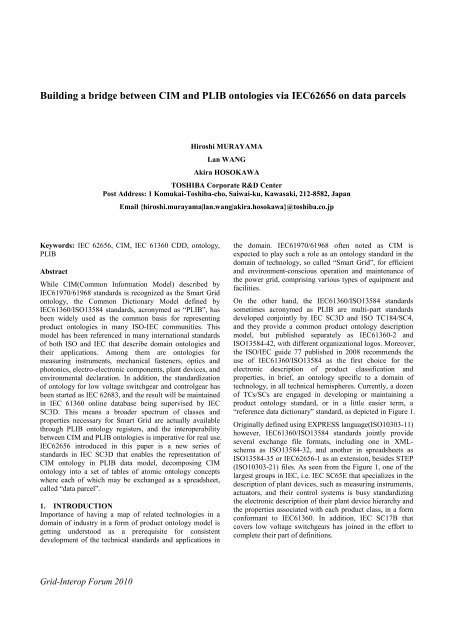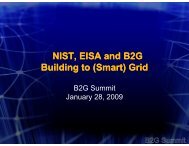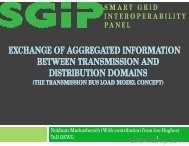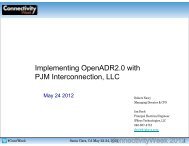Building a bridge between CIM and PLIB ontologies via IEC62656 ...
Building a bridge between CIM and PLIB ontologies via IEC62656 ...
Building a bridge between CIM and PLIB ontologies via IEC62656 ...
Create successful ePaper yourself
Turn your PDF publications into a flip-book with our unique Google optimized e-Paper software.
<strong>Building</strong> a <strong>bridge</strong> <strong>between</strong> <strong>CIM</strong> <strong>and</strong> <strong>PLIB</strong> <strong>ontologies</strong> <strong>via</strong> <strong>IEC62656</strong> on data parcels<br />
Hiroshi MURAYAMA<br />
Lan WANG<br />
Akira HOSOKAWA<br />
TOSHIBA Corporate R&D Center<br />
Post Address: 1 Komukai-Toshiba-cho, Saiwai-ku, Kawasaki, 212-8582, Japan<br />
Email {hiroshi.murayama|lan.wang|akira.hosokawa}@toshiba.co.jp<br />
Keywords: IEC 62656, <strong>CIM</strong>, IEC 61360 CDD, ontology,<br />
<strong>PLIB</strong><br />
Abstract<br />
While <strong>CIM</strong>(Common Information Model) described by<br />
IEC61970/61968 st<strong>and</strong>ards is recognized as the Smart Grid<br />
ontology, the Common Dictionary Model defined by<br />
IEC61360/ISO13584 st<strong>and</strong>ards, acronymed as “<strong>PLIB</strong>”, has<br />
been widely used as the common basis for representing<br />
product <strong>ontologies</strong> in many ISO-IEC communities. This<br />
model has been referenced in many international st<strong>and</strong>ards<br />
of both ISO <strong>and</strong> IEC that describe domain <strong>ontologies</strong> <strong>and</strong><br />
their applications. Among them are <strong>ontologies</strong> for<br />
measuring instruments, mechanical fasteners, optics <strong>and</strong><br />
photonics, electro-electronic components, plant devices, <strong>and</strong><br />
environmental declaration. In addition, the st<strong>and</strong>ardization<br />
of ontology for low voltage switchgear <strong>and</strong> controlgear has<br />
been started as IEC 62683, <strong>and</strong> the result will be maintained<br />
in IEC 61360 online database being supervised by IEC<br />
SC3D. This means a broader spectrum of classes <strong>and</strong><br />
properties necessary for Smart Grid are actually available<br />
through <strong>PLIB</strong> ontology registers, <strong>and</strong> the interoperability<br />
<strong>between</strong> <strong>CIM</strong> <strong>and</strong> <strong>PLIB</strong> <strong>ontologies</strong> is imperative for real use.<br />
<strong>IEC62656</strong> introduced in this paper is a new series of<br />
st<strong>and</strong>ards in IEC SC3D that enables the representation of<br />
<strong>CIM</strong> ontology in <strong>PLIB</strong> data model, decomposing <strong>CIM</strong><br />
ontology into a set of tables of atomic ontology concepts<br />
where each of which may be exchanged as a spreadsheet,<br />
called “data parcel”.<br />
1. INTRODUCTION<br />
Importance of having a map of related technologies in a<br />
domain of industry in a form of product ontology model is<br />
getting understood as a prerequisite for consistent<br />
development of the technical st<strong>and</strong>ards <strong>and</strong> applications in<br />
the domain. IEC61970/61968 often noted as <strong>CIM</strong> is<br />
expected to play such a role as an ontology st<strong>and</strong>ard in the<br />
domain of technology, so called “Smart Grid”, for efficient<br />
<strong>and</strong> environment-conscious operation <strong>and</strong> maintenance of<br />
the power grid, comprising various types of equipment <strong>and</strong><br />
facilities.<br />
On the other h<strong>and</strong>, the IEC61360/ISO13584 st<strong>and</strong>ards<br />
sometimes acronymed as <strong>PLIB</strong> are multi-part st<strong>and</strong>ards<br />
developed conjointly by IEC SC3D <strong>and</strong> ISO TC184/SC4,<br />
<strong>and</strong> they provide a common product ontology description<br />
model, but published separately as IEC61360-2 <strong>and</strong><br />
ISO13584-42, with different organizational logos. Moreover,<br />
the ISO/IEC guide 77 published in 2008 recommends the<br />
use of IEC61360/ISO13584 as the first choice for the<br />
electronic description of product classification <strong>and</strong><br />
properties, in brief, an ontology specific to a domain of<br />
technology, in all technical hemispheres. Currently, a dozen<br />
of TCs/SCs are engaged in developing or maintaining a<br />
product ontology st<strong>and</strong>ard, or in a little easier term, a<br />
“reference data dictionary” st<strong>and</strong>ard, as depicted in Figure 1.<br />
Originally defined using EXPRESS language(ISO10303-11)<br />
however, IEC61360/ISO13584 st<strong>and</strong>ards jointly provide<br />
several exchange file formats, including one in XMLschema<br />
as ISO13584-32, <strong>and</strong> another in spreadsheets as<br />
ISO13584-35 or <strong>IEC62656</strong>-1 as an extension, besides STEP<br />
(ISO10303-21) files. As seen from the Figure 1, one of the<br />
largest groups in IEC, i.e. IEC SC65E that specializes in the<br />
description of plant devices, such as measuring instruments,<br />
actuators, <strong>and</strong> their control systems is busy st<strong>and</strong>ardizing<br />
the electronic description of their plant device hierarchy <strong>and</strong><br />
the properties associated with each product class, in a form<br />
conformant to IEC61360. In addition, IEC SC17B that<br />
covers low voltage switchgears has joined in the effort to<br />
complete their part of definitions.<br />
Grid-Interop Forum 2010
MURAYAMA, WANG, <strong>and</strong> HOSOKAWA<br />
IS O T C4<br />
IE C 6 13 6 0 -ISO 13 5 8 4 m o de l h as it s o w n follo we rs fo r<br />
te c h nic al a sse t m a n ag e m e nt<br />
I S O T C10 / SC 10 IS O TC 29 /W G 34 IS O T C17 2<br />
IE C S C65 E<br />
I E C S C1 7 B<br />
R oller B earin gs<br />
IS O 21107<br />
P ro cess pl ant<br />
C uttin g too ls<br />
IS O 13399<br />
O ptics<br />
IS O2 3584<br />
P lant Devices<br />
I EC 61987<br />
L V-S w itchg ear<br />
IE C NP<br />
IS O T C2<br />
IS O T C 184/S C 4/W G 2<br />
Fastener<br />
IS O13 584-511<br />
on tolo gy develop men t<br />
princip le<br />
IS O 13584-42/IEC61360-1<br />
IE C S C 3D<br />
Measur ing in stru men ts<br />
IS O 13584 -501<br />
data mo del<br />
IS O 13584-42/IEC61360-2<br />
Data Inter face<br />
IS O 13584-35/<strong>IEC62656</strong>-1<br />
IE C61360-4<br />
Com m o n D ata Dictionar y<br />
O nline server<br />
d om a in ont olo gy<br />
m od el, prin ciple, e tc<br />
Gu id eline<br />
IS O /IE C G ui de77-1,-2 ,-3<br />
IS O IE C /JW G1<br />
Com m o n m ain tenance p rocedu re<br />
IS O /IE C D irectiv es<br />
IE C SM B<br />
Figure 1 Collaboration <strong>and</strong> cooperation with IEC SC3D for IEC61360 CDD<br />
The both committees intend to register the dictionary<br />
definitions in IEC 61360 CDD (Component Data<br />
Dictionary), an online database of <strong>ontologies</strong> maintained by<br />
IEC SC3D in collaboration with IEC Central Office (IEC-<br />
CO) for IT-infrastructure. Separately, in IEC TC111<br />
environmental properties necessary to be declared for<br />
manufactured products are designed to keep basic<br />
interoperability with IEC61360/ISO13584, <strong>and</strong> a plan to<br />
register the specification of the properties in IEC61360<br />
CDD is underway. The reason behind this is that IEC61360<br />
CDD is allowed to maintain <strong>and</strong> update its content though a<br />
database procedure stipulated in IEC directive annex-J, <strong>and</strong><br />
this allows an update of content within 4 to 6 months. If a<br />
change request is submitted <strong>and</strong> approved, it will become an<br />
integral part of IEC61360 CDD immediately without<br />
normal IEC documentation <strong>and</strong> publication process at IEC<br />
Central Office. This fits well with the purpose <strong>and</strong><br />
requirements of industrial ontology registry, where a wide<br />
range of products are already in service, new types of<br />
products are put on the market every month, <strong>and</strong> new<br />
requirements on products or new use of products are<br />
introduced or discovered in a short term. For example, a<br />
wind turbine is not yet listed as an equipment type in <strong>CIM</strong><br />
st<strong>and</strong>ard, however some countries are already planning to<br />
test a type of wind turbine on a float in the sea. Thus even if<br />
a wind turbine is already an item in the <strong>CIM</strong>, it may require<br />
additional properties to be st<strong>and</strong>ardized for efficient<br />
performance <strong>and</strong> maintenance of the equipment, such as<br />
wave height or sea level for the equipment in a very short<br />
time frame.<br />
Meanwhile, in private sectors, several industry consortia<br />
maintain data dictionaries in a form compatible with<br />
IEC61360/ISO13584. One of such organizations is eCl@ss<br />
in Europe <strong>and</strong> another is JEITA/ECALS which latter<br />
concentrates on the definition of electric/electronic parts in<br />
Japan. A consortia of organizations including EdF, Renault,<br />
PSA as members in France has been engaged in building a<br />
ISO 13584 based simple dictionary, accumulating the<br />
product classes <strong>and</strong> their properties for production<br />
equipment <strong>and</strong> facilities.<br />
Unfortunately, the <strong>CIM</strong> st<strong>and</strong>ardization started well before<br />
the publication of the guide 77, <strong>and</strong> consequently, its<br />
ontology model is defined in UML (Unified Modeling<br />
Language) <strong>and</strong> RDF Schema is principally used for<br />
exchange of <strong>ontologies</strong>. Thus, the two st<strong>and</strong>ards are<br />
structurally incoherent, <strong>and</strong> no effort for bridging the two<br />
structures has been tried nor planned until this day.<br />
Thus the aim <strong>and</strong> scope of this paper is to show first why<br />
the interoperability <strong>between</strong> the two st<strong>and</strong>ards is so critical<br />
for the success of the Smart Grid. Secondly, to illustrate the<br />
additional advantages to be accrued from having a central<br />
repository of relevant data dictionaries <strong>and</strong> keeping the<br />
information flow among the applications <strong>and</strong> domains. And<br />
thirdly to introduce <strong>IEC62656</strong>, in particular the part3 of the<br />
series, as a means to <strong>bridge</strong> the gap <strong>between</strong> <strong>CIM</strong> <strong>and</strong> <strong>PLIB</strong>.<br />
Grid-Interop Forum 2010
MURAYAMA, WANG, <strong>and</strong> HOSOKAWA<br />
2. <strong>CIM</strong> AND ITS LIMITS<br />
2.1. Current <strong>CIM</strong> as observed<br />
When we observe <strong>CIM</strong> in comparison with other<br />
ontological models, the following points are notable:<br />
a) References among objects are made by names.<br />
b) Each object or relation has no version.<br />
c) No object by object update is foreseen.<br />
An implication of these is that <strong>CIM</strong> is designed with rare<br />
occasional <strong>and</strong> holistic update in mind.<br />
A simplified view of the basic <strong>CIM</strong> structures extracted<br />
from an RDF version of <strong>CIM</strong>, i.e., IEC61970-501 is<br />
illustrated in Figure 2, whereas the original <strong>CIM</strong> model is<br />
defined in IEC61970-301 st<strong>and</strong>ard using Rational Rose, a<br />
commercial graphic design tool of UML, marketed by IBM<br />
corporation. Such specification of the name of a commercial<br />
tool in an International St<strong>and</strong>ard is very rare, but from the<br />
description in Part301, it seems the use of the tool is<br />
prerequisite for an accurate <strong>and</strong> effective update of the <strong>CIM</strong><br />
model. And it seems there is an assumption that all the<br />
components of a power grid, or at least their descriptions as<br />
parts of an ontology, can be updated simultaneously. This<br />
looks like quite an optimistic assumption in real use. When<br />
the model is used only for a limited number of installations<br />
of software, say in case of a few EMS’ s, it may be<br />
guaranteed that all software installations <strong>and</strong> their<br />
applications in a micro-grid may correspond to one version<br />
of <strong>CIM</strong>. However, an intelligent electric device or a facility<br />
in a power grid has considerably a long life span <strong>and</strong> some<br />
parts of the software functions might be hard-wired or<br />
tightly embedded into the equipment <strong>and</strong> facilities as<br />
integral elements. In this case, it is not likely that all these<br />
software components in a power grid will be updated all at<br />
once, even if some packages of <strong>CIM</strong> in a UML may be<br />
updated in a tool. Then a situation may arise where the<br />
software components in a power grid correspond to different<br />
versions of <strong>CIM</strong>. This means operations on added attributes,<br />
classes, <strong>and</strong> relations by a control device designed with a<br />
newer <strong>CIM</strong> may not function properly on some electric<br />
devices or facilities as the power grid becomes older.<br />
This becomes all the more complex when the role of<br />
reference to an object is not separated from the role of the<br />
name meanwhile the role of identification <strong>and</strong> the role of<br />
reference of an object are not clearly separated. To be more<br />
precise, reference among the entities is done by the nameinclusive<br />
ID, namely URI(Uniform Resource Identifier).<br />
URI_c1<br />
URI_c2<br />
Rdfs:range<br />
501:Common Information Model Resource<br />
IEC61970- Description Framework (<strong>CIM</strong> RDF) schema<br />
Rdfs:domain<br />
subClassOf<br />
Property1<br />
URI_p1<br />
Figure 2 simplified view of <strong>CIM</strong> data model<br />
Reference mechanism in <strong>PLIB</strong> <strong>and</strong> POM<br />
Definition class<br />
Class1<br />
Class2<br />
ID_c2<br />
Property1<br />
Supplier iD<br />
Property2<br />
URI_p2<br />
DataType (incl. unit)<br />
isDefinedBy<br />
Rdfs:domain<br />
ID_p1<br />
isDefinedBy<br />
isDefinedBy<br />
Class1<br />
Class2<br />
Super class<br />
Super class<br />
Described by<br />
ID_p2<br />
PackageA<br />
PackageB<br />
ID_c1<br />
Definition class<br />
Property2<br />
not<br />
avaliable in<br />
the RDF<br />
Figure 3 Simplified view of <strong>PLIB</strong> <strong>and</strong> POM data model<br />
2.2. Current <strong>PLIB</strong> as observed<br />
In contrast in <strong>PLIB</strong> (also in POM), a name <strong>and</strong> an identifier<br />
are two different functionalities <strong>and</strong> are completely separate.<br />
In fact, <strong>PLIB</strong> supposes there may be different appellations<br />
for the same object in each domain <strong>and</strong> in language, thus an<br />
ontology network is constructed in reference to a global ID<br />
including a version as its essential element, not by a name.<br />
This means each meta-object(class, property or relation) is<br />
defined with an appropriate version as one of its attributes.<br />
From more a pragmatic viewpoint, one of the conspicuous<br />
shortfalls of the UML is that UML itself is not an ontology<br />
definition language but a graphical programming language,<br />
thus a limited capability exists for fully accounting the<br />
definitions of the classes <strong>and</strong> properties as an ontology.<br />
Moreover, when a difference <strong>between</strong> 2 <strong>ontologies</strong> is sent in<br />
a file from one party to another, the difference is not<br />
guaranteed to be processible as a UML, since the result<br />
might be an orphanated attribute, <strong>and</strong> difficult to be<br />
Grid-Interop Forum 2010
MURAYAMA, WANG, <strong>and</strong> HOSOKAWA<br />
displayed as a UML graph. In other words, a semantic block<br />
of ontology that needs to be analyzed <strong>and</strong> a syntactic block<br />
of a programming language that can be displayed by UML<br />
are not the same. This poses a significant question if UML<br />
is the best form of definition for <strong>CIM</strong>, from the viewpoint of<br />
continuous maintenance <strong>and</strong> rapid expansion of the<br />
definitions of the <strong>CIM</strong> as ontology. It seems rather<br />
distantiating those who fully underst<strong>and</strong> the grid ontology<br />
<strong>and</strong> could contribute to its expansion. Additionally, it can be<br />
also pointed out that the present <strong>CIM</strong> has only one version<br />
for the whole ontology, <strong>and</strong> element by element update,<br />
such as insertions of a new class or property is not foreseen.<br />
This slows down both the qualitative <strong>and</strong> quantitative<br />
extension of the <strong>CIM</strong> st<strong>and</strong>ards, <strong>and</strong> reduces the<br />
opportunities for harmonizing with other st<strong>and</strong>ards: An<br />
ontology st<strong>and</strong>ard must have a sophisticated version control<br />
mechanism as a whole as well as for its parts.<br />
2.3. Ontology modeling with POM<br />
For any product ontology to be used, not for an academic<br />
pursuit or publicity, but for a day to day industrial activity,<br />
the following conditions must be squarely addressed:<br />
a) Ease of integration with other domain <strong>ontologies</strong>.<br />
b) Ease of extension for new entries<br />
c) Ease of use <strong>and</strong> application for domain engineers.<br />
The Parcellized Ontology Model or POM in short is one of<br />
the new st<strong>and</strong>ard frameworks to address the above. The<br />
POM has four layers of ontology representation each of<br />
which consists of pairs of abstraction levels; M4-M3, M3-<br />
M2, M2-M1, <strong>and</strong> M1-MO in the terminology of Meta<br />
Object Facility (MOF) of OMG. Each layer comprises a<br />
header section <strong>and</strong> a data section that can be represented in a<br />
table or matrix form, as depicted in Figure 4.<br />
Figure 4 Parcel Example<br />
The four layers of POM are short named as AO, MO, DO,<br />
<strong>and</strong> DL that represent respectively Axiomatic Ontology,<br />
Meta Ontology, Domain Ontology, <strong>and</strong> Domain Library in<br />
<strong>IEC62656</strong> series of st<strong>and</strong>ard. One of the unique features of<br />
POM is that a layer of ontology is represented as instances<br />
of the layer directly above. Thus the four layer structure of<br />
POM forms a hierarchy depicted schematically as in Figure<br />
5.<br />
AO(M4-M3) MO(M3-M2) DO(M2-M1) DL( M1-M0 )<br />
Axiomatic Ontology Meta Ontology Domain Ontology Domain Library<br />
Axiomatic Ontology -<br />
as Schema -<br />
structures<br />
Axiomatic Ontology<br />
-<br />
as instance<br />
Axiomatic Ontology -<br />
as Schema -<br />
Meta ontology -<br />
as instance<br />
structures<br />
Meta ontology -<br />
as Schema<br />
Domain ontology<br />
as instance<br />
-<br />
structures<br />
Parcellized Ontology Model (POM) Modeling Layers<br />
Figure 5 POM object modeling layers<br />
Notation<br />
Schema<br />
instance<br />
Domain ontology<br />
as Schema<br />
Domain Library<br />
Instance data<br />
Note that a model for a domain ontology at DO is defined as<br />
a set of instances of an upper layer MO. This means if we<br />
modify the instances of the upper layer, i.e., MO, then the<br />
model of a domain ontology at DO will be largely affected.<br />
For constraining the changes at MO, however, there is AO,<br />
thus all the changes must be consistent <strong>and</strong> conformant with<br />
the framework set by AO.<br />
2.4. Theoretical basis of POM<br />
The above layered ontology structure, starting from AO to<br />
DL, is an application of a well known theorem in<br />
mathematical logic i.e., Reduction Theorem as part of a<br />
proof of Completeness Theorem of Kurt Gödel.<br />
Let’s say A is a logical formula containing a free variable in<br />
mathematical logic, the following theorem is known as<br />
substitution theorem:<br />
where<br />
A<br />
A ® $ aA ,<br />
means A is assumed to be true.<br />
Namely, if A is assumed true then there must be at least<br />
one instance a such that replacing x by a in A makes A<br />
true.<br />
Now let a theory<br />
variables<br />
1 2<br />
j j<br />
rewritten as; A = A [ x1, x2, , x k<br />
] .<br />
j<br />
A be a logical formula, with k free<br />
x = [ x , x , , x k<br />
] . Then the formula may be<br />
If there is<br />
1 2<br />
a to x makes<br />
a = [ a , a , , a k<br />
] such that assignment of<br />
j<br />
A true, then we may rewrite this as;<br />
j<br />
a A .<br />
Grid-Interop Forum 2010
MURAYAMA, WANG, <strong>and</strong> HOSOKAWA<br />
Applying the substitution theorem one by one to k free<br />
variables we obtain,<br />
where$ a means<br />
A<br />
j<br />
j<br />
® $ aA ,<br />
.<br />
$ a $ a $ a<br />
1 2 k<br />
j 1<br />
A -<br />
Now we further assume is a logical formula that is<br />
made up of a finite number of logical conjunction or<br />
disjunction of the terms; a a a .<br />
a Î<br />
, , ,<br />
k<br />
1 2<br />
Note that when<br />
i [1, k ]<br />
is true, the result of any number of<br />
logical conjunctions of a<br />
i<br />
is true <strong>and</strong> the result of any<br />
number of logical disjunctions of<br />
true. This means,<br />
j 1<br />
A -<br />
a<br />
i<br />
is true, thus<br />
j j j 1<br />
A ® $ aA ® A -<br />
.<br />
j 1<br />
A -<br />
Assume that still contains some other free variables<br />
j 1<br />
a¢ . Then we apply the above process to , A -<br />
<strong>and</strong> we<br />
have<br />
A<br />
® $ a¢<br />
A .<br />
j-1 j-1<br />
In a repeated application of the above process, we will have<br />
j j j-1 1<br />
A ® $ aA ® $ a¢<br />
A ® ® $ eA ,<br />
e = [ e , e , , e k<br />
] signifies a list of the values of<br />
where 1 2<br />
real world objects, or constants, such as<br />
[ 100, 2.3, Yokohama, <strong>IEC62656</strong>] ,<br />
that is made up of constants (individuals) <strong>and</strong> no more<br />
j 1<br />
reducible. Or we can replacing a¢ with a - , the above<br />
may expressed the same formula for j = 4 as ;<br />
4 3 4 2 3 1 2 1<br />
A ® $ a A ® $ a A ® $ a A ® $ eA .<br />
j-1<br />
j<br />
And the readers are easy to see, that $ a A corresponds<br />
to either one of four layers of POM, namely;<br />
AO Û $ a 3 A<br />
4<br />
, MO Û $ a 2 A<br />
3<br />
, DO Û<br />
<strong>and</strong><br />
DL Û<br />
0 1<br />
$ e A .<br />
is<br />
1 2<br />
$ a A ,<br />
This implies POM is very deeply founded in mathematical<br />
logic, unlike its easy outlook as “spreadsheets”. And<br />
because of this 4 layer architecture, the POM is a metalanguage<br />
for many modeling languages including POM<br />
itself. For POM, <strong>CIM</strong> is just one of such languages to be<br />
modelled <strong>and</strong> <strong>PLIB</strong> is another.<br />
3. ONTOLOGY BY DATABASE PROCEDURE<br />
As noted earlier, an ontology register with the scope<br />
spanning all the ranges of electrotechnical products <strong>and</strong><br />
services are maintained at IEC SC3D as IEC 61360 CDD<br />
through the IEC database procedure described in IEC<br />
supplementary directive annex-J. Figure 6 gives a simplified<br />
view of the procedure in contrast with the paper based<br />
st<strong>and</strong>ardization process.<br />
Paper(incl.PDF) based ontology st<strong>and</strong>ard maintenance such as current<br />
<strong>CIM</strong> vis-à-vis database procedure allowed for IEC61360 CDD<br />
IEC St<strong>and</strong>ard Procedure(PDF・paper based)<br />
Not enough attributes for secondary<br />
battery<br />
NP:New work item Proposal<br />
WD:Working Draft<br />
CDV:Committee Draft for Vote<br />
FDIS:Final Draft International St<strong>and</strong>ard<br />
IS:International St<strong>and</strong>ard<br />
Check by<br />
person<br />
Check by<br />
person<br />
Provide as PDF or paper<br />
Several years later, it<br />
becomes possible to use new<br />
<strong>CIM</strong> st<strong>and</strong>ard<br />
2~3 Years、Max 5 years<br />
IEC CDD Procedure(IEC61360 + <strong>IEC62656</strong>)<br />
Change Request<br />
Evaluation<br />
Validation<br />
DataBase<br />
Release<br />
Register data with ParcelMaker<br />
Auto<br />
consistency<br />
check<br />
It’s about half a year to<br />
use new <strong>CIM</strong> st<strong>and</strong>ard<br />
EMS/DMS/SCADA,etc.<br />
Figure 6 Database procedure at a glance<br />
Currently, the dictionary upload/download interface is being<br />
switched into <strong>IEC62656</strong>-1/ISO/TS 13584-35 based one for<br />
the ease of compilation of data by domain experts. Since the<br />
physical format of the Parcel format is the spreadsheet, the<br />
format can be easily processed by many commercial<br />
spreadsheet tools such as MS-EXCEL® 1 . There are a few<br />
organizations that have developed a tool to process data<br />
parcels. ParcelMaker TM is one of such tools that is available<br />
from TOSHIBA Corporation as an add-in program to MS-<br />
EXCEL®, <strong>and</strong> all those who are engaged in an ontology<br />
st<strong>and</strong>ard development conformant to IEC61360 <strong>via</strong> IEC<br />
62656-1 may obtain a copy without charge. A screen copy<br />
of the class hierarchy view of <strong>CIM</strong> generated by<br />
ParcelMaker TM is shown in Figure 7, while the Figure 8<br />
shows the base ontology data implemented in a class metaclass<br />
spreadsheet conformant to <strong>IEC62656</strong>-1 obtained as an<br />
early result of the experiment for translating <strong>CIM</strong> into POM,<br />
i.e., IEC 62656-1 format. In our implementation using the<br />
tool, we found that the entire <strong>CIM</strong> ontology can be<br />
translated into POM based ontology with few functional<br />
extensions to the IEC/CD 62656-1, <strong>and</strong> may cohabitate with<br />
1 MS-EXCEL is a registered trademark of Microsoft Corporation.<br />
4 to 6 Months<br />
Grid-Interop Forum 2010
MURAYAMA, WANG, <strong>and</strong> HOSOKAWA<br />
ISO13584-42/IEC61360-2 conformant ontology definitions<br />
in an extended IEC CDD. All these additional modeling<br />
constructs are included in IEC/CDV 62656 <strong>and</strong> all the<br />
mapping principles <strong>and</strong> rules to transplant <strong>CIM</strong> defined<br />
ontology data into IEC CDD will be st<strong>and</strong>ardized as Part3<br />
of the <strong>IEC62656</strong> series.<br />
The prime advantage of translating the <strong>CIM</strong> content into<br />
Parcel based expression is that the latter can be easily<br />
integrated with other ontology definitions available in IEC<br />
CDD. For example, switchgear definitions will be available<br />
<strong>and</strong> more than 50 technical properties already defined for<br />
secondary batteries in IEC CDD are reused or imported or<br />
referenced for use in Smart Grid including <strong>CIM</strong> definitions.<br />
Secondly, because IEC CDD is maintained by the database<br />
procedure, the ontology build-up <strong>and</strong> its maintenance are<br />
much easier <strong>and</strong> faster than current <strong>CIM</strong>. Moreover what is<br />
modified by change request <strong>and</strong> approved by online vote<br />
will immediately have an IS status, <strong>and</strong> available to users.<br />
Lastly, since the full definition can be treated in a<br />
spreadsheet, it is easy to process the data for domain experts.<br />
Moreover, the data can be preprocessed or post-processed<br />
easily from other applications. This will eventually serve as<br />
an efficient <strong>and</strong> st<strong>and</strong>ardized interface for asset management<br />
of <strong>CIM</strong> related products <strong>and</strong> services. Figure 9 shows the<br />
current map for the integration of various <strong>ontologies</strong> that are<br />
being or planned to be transformed into POM <strong>and</strong> interfaced<br />
or directly transplanted into an extended IEC CDD.<br />
Figure 7 <strong>CIM</strong> class<br />
Figure 8 Class meta-class implemented as a spreadsheet on MS-EXCEL<br />
Grid-Interop Forum 2010
MURAYAMA, WANG, <strong>and</strong> HOSOKAWA<br />
IEC 62656-3 :Extended Interface for <strong>CIM</strong> Interoperability<br />
For real sustainability of Smart grid, integration of the attributes is imperative.<br />
<strong>CIM</strong> World<br />
T&D Mgmt<br />
Outage Mgmt<br />
Substation<br />
IEC61970/61968 <strong>CIM</strong>=Power grid specific ontology model<br />
<strong>CIM</strong> -RDF<br />
IEC61970 –X?<br />
You find in IEC CDD the<br />
manufacturer, spare part,<br />
life time for the<br />
switchgear, that you can’t<br />
in <strong>CIM</strong> !<br />
<strong>PLIB</strong> World<br />
Bridge btw <strong>CIM</strong> <strong>and</strong> <strong>PLIB</strong><br />
<strong>IEC62656</strong>-3<br />
Parcel<br />
(IEC 62656-1)<br />
IEC <strong>CIM</strong><br />
DB<br />
~<br />
IEC 61360<br />
CDD<br />
<strong>PLIB</strong> (IEC61360/ISO13584)=IEC・ISO common dictionary model<br />
IEC TC111<br />
DB<br />
IEC 62474<br />
SC65E<br />
plant devices<br />
DB<br />
IEC SC17B<br />
Low voltage<br />
Switchgear DB<br />
PFI(Fr)<br />
DB<br />
ECALS DB<br />
eCl@ss DB<br />
NAMUR<br />
(118 Organizations)<br />
Aprox.130<br />
Organizations<br />
Aprox. 100 Organizations<br />
Aprox.100<br />
Organizations<br />
Figure 9 Map for integration of product <strong>ontologies</strong> <strong>via</strong> <strong>IEC62656</strong><br />
4. SUMMARY<br />
IEC SC3D <strong>and</strong> TC57 are in a move to set up a formal<br />
liaison relationship. As precisely described in IEC SMB-<br />
SG3 Roadmap[9], “This would, inter alia, promote the<br />
extension of existing (technical) properties in the existing<br />
data models of IEC 61850/61968 <strong>and</strong> 61970 to other<br />
applications <strong>and</strong> would open the path to new applications.<br />
Conversely, the interoperability of the <strong>CIM</strong> <strong>and</strong> <strong>PLIB</strong><br />
st<strong>and</strong>ards will bring much benefit to those who need<br />
<strong>ontologies</strong> in an electric power industry, because the<br />
engineers in the industry will be able to access through a<br />
st<strong>and</strong>ardized interface <strong>and</strong> st<strong>and</strong>ardized identification<br />
methods the information about non-power-electric<br />
properties of the equipment <strong>and</strong> facilities in electric grids,<br />
such as material of equipment, environmental conditions,<br />
engineering information, or spare parts information that are<br />
indispensable for effective maintenance of the Smart Grid<br />
facilities. For this, we have illustrated throughout this paper<br />
that POM should play a pivotal role in mapping <strong>and</strong><br />
interfacing the two st<strong>and</strong>ards, because POM has a metaontology<br />
layer to model <strong>and</strong> map different <strong>ontologies</strong>, <strong>and</strong><br />
can express those different domain <strong>ontologies</strong> in a<br />
consistent <strong>and</strong> harmonious manner in the same framework.<br />
Additionally, ontology in a spreadsheet format will bring<br />
about practical convenience to the domain experts. For this,<br />
IEC 62656 Part 3, as an extended interface for <strong>CIM</strong><br />
interoperability is being st<strong>and</strong>ardized at IEC SC3D.<br />
Needless to say, that the reuse of the definitions of classes<br />
<strong>and</strong> properties available from IEC CDD or from <strong>CIM</strong> in the<br />
other st<strong>and</strong>ard will considerably reduce the cost of<br />
st<strong>and</strong>ardization in both committees.<br />
Lastly but most importantly, we propose that the future<br />
maintenance of <strong>CIM</strong> content be in an extended IEC CDD<br />
database, conformant to the IEC database procedure. This<br />
will bring about agility in the response of the smart grid<br />
community to various change requests from industry to<br />
substantiate or correct <strong>CIM</strong>. This agility will also help<br />
harmonize the <strong>CIM</strong> with IEC61850 series of the st<strong>and</strong>ard in<br />
a shorter time frame. Because not only <strong>CIM</strong> but also the<br />
essential data structures of IEC61850 may be useful for<br />
registration as IEC CDD definitions.<br />
We hope that the US Smart Grid communities will study the<br />
possibility of harvesting the fruit of IEC CDD <strong>and</strong> apply the<br />
means <strong>and</strong> methods of the collective ontology maintenance<br />
developed by IEC SC3D over years.<br />
Grid-Interop Forum 2010
MURAYAMA, WANG, <strong>and</strong> HOSOKAWA<br />
Reference<br />
[1]IEC 62656-1,”St<strong>and</strong>ardized product ontology register<br />
<strong>and</strong> transfer by spreadsheets-part1:Logical Structure for<br />
data parcels”<br />
[2]IEC 62656-2,”St<strong>and</strong>ardized product ontology register<br />
<strong>and</strong> transfer by spreadsheets-Part2:Implementation guide<br />
for data parcels ”<br />
[3]IEC 61360-1:2009,”st<strong>and</strong>ard data element types with<br />
associated classification scheme for electric components-<br />
Part1: Definitions-Principles <strong>and</strong> methods”<br />
[4]IEC 61360-4:1998,”st<strong>and</strong>ard data element types with<br />
associated classification scheme for electric components-<br />
Part4: IEC Reference collection of st<strong>and</strong>ard data element<br />
types, component classes <strong>and</strong> terms”<br />
[5]ISO 13584-42:2010,”Industrial Automation Systems <strong>and</strong><br />
Integration-Parts Library-Part42:Methodology for<br />
structuring part families”<br />
[6]IEC 61970-301:2010,”Energy management system<br />
application program interface(EMS-API)-Part301:Common<br />
Information Model(<strong>CIM</strong> ) Base”<br />
[7]IEC 61970-501:2006,”Energy management system<br />
application program interface(EMS-API)-Part501:Common<br />
Information Model Resource Description Framework(<strong>CIM</strong><br />
RDF) schema“<br />
[8]IEC 61968-13:2008,”Application integration at electric<br />
utilities-System interfaces for distribution management-<br />
Part13: <strong>CIM</strong> RDF Model exchange format for distribution”<br />
[9]2010,”IEC Smart Grid St<strong>and</strong>ardization Roadmap”, SMB<br />
Smart Grid Strategic Group (SG3)<br />
Biography<br />
Mr. Hiroshi MURAYAMA is a chief research scientist at<br />
Toshiba corporate research center. He is also serving as<br />
chairman of IEC SC3D, a horizontal subcommittee of IEC,<br />
in charge of development <strong>and</strong> maintenance of technical<br />
st<strong>and</strong>ards for product properties <strong>and</strong> classes <strong>and</strong> their<br />
identification, for all electro-technical domains. He has led<br />
the development of several International st<strong>and</strong>ards as project<br />
leader in both ISO <strong>and</strong> IEC communities over a decade.<br />
Ms. Lan WANG is a research engineer at Toshiba corporate<br />
research center, who is now preparing Part3 of the IEC<br />
62656 series st<strong>and</strong>ard with her colleagues, as an interface<br />
st<strong>and</strong>ard <strong>between</strong> <strong>CIM</strong> <strong>and</strong> IEC CDD. She also takes care of<br />
analyzing the present content of <strong>CIM</strong> <strong>and</strong> transplanting into<br />
IEC CDD test database <strong>via</strong> Parcel tools. The Part3 will<br />
allow the representation of <strong>CIM</strong> <strong>and</strong> <strong>PLIB</strong> <strong>ontologies</strong> on the<br />
same IT-infrastructure.<br />
Mr. Akira HOSOKAWA is a research engineer at Toshiba<br />
corporate research center, who is currently leading the<br />
development of Part2 of the IEC 62656 series st<strong>and</strong>ard,<br />
designed as an implementation guide for the logical model<br />
defined in Part1. The st<strong>and</strong>ard will be particularly useful for<br />
registering an ontology of product classes <strong>and</strong> properties in<br />
IEC CDD, an online database maintained by IEC Central<br />
Office. He also leads the development of an editing tool in<br />
the company, named ParcelMaker TM , for practical<br />
spreadsheet-representation of <strong>ontologies</strong>.<br />
Grid-Interop Forum 2010









